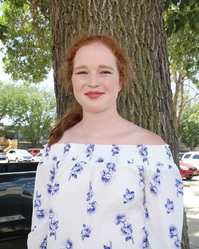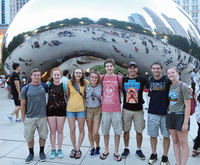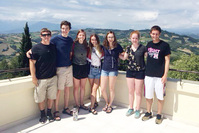For one of her latest projects, Lauren Schild spent time at a brewery — but she didn’t drink the beer.
It was all in the name of science.
“They’re doing a lot of research on the biology side of it,” she said of the craft brewers.
The 2018 Yankton High School graduate made the field trip as one of eight Davis-Bahcall Scholars chosen from an original field of 40 applicants. She spent four weeks this summer exploring research at some of the nation’s leading laboratories and universities.
The program is sponsored by the Sanford Underground Research Facility, Black Hills State University, the South Dakota Space Grant Consortium and First Premier Bank.
Schild spent one week at the Sanford Underground Research Facility in the Black Hills. In addition, she traveled to other research laboratories in the United States and Italy.
Closer to home, one of the stops included the Fernson Brewing Company of Sioux Falls, Schild said. It’s all part of the Davis-Bahcall program’s broader look at promising research, even if not at first glance.
“At Fernson, they’re working with different hops and temperatures and with ways of brewing for different flavors for the beer,” she said. “Different bacteria and micro-organisms are needed for producing the proper flavors. If you brew it too hot, it produces a barnyard flavor.”
The next step could produce even more valuable information.
“Researchers are working with DNA testing to find out what (beer) flavors different people can taste. They can then tailor flavors to them. You have a little card and pick out the flavors they like,” she said.
“Right now, they’re at the point where the DNA sample is sent away. It takes a while to get the results. But in the future, they hope to process the DNA really fast.”
The process can hold implications for obtaining faster DNA results, Schild said.
At another Sioux Falls site, the Sanford research lab performs DNA testing for rare children’s diseases such as certain cancers and muscular dystrophy, she added.
“At the Sanford Research Lab, they can take a skin sample and turn it into a stem cell. They can also turn it into a nerve cell or brain cell. It’s interesting how they can take one cell that’s already following instructions and be able to change it,” she said.
“The (Sanford) Children’s Hospital sends a bunch of samples over to (the lab), if the parents give consent, so they can research different things that affect children. They have researchers seeking cures.”
The Sanford lab has taken on a very fluid approach in the areas where research takes them, Schild said.
“They are researching a lot of different things. Some of it ends up working better for something else, so they switch over,” she said. “They have a lot of different stages of testing before it even goes to human trials.”
The research has already resulted in one benefit, Schild said. Test results come back in a day rather than a week.
This summer’s experiences held a special fascination for Schild, who is entering the University of South Dakota. She is majoring in medical biology with a goal of becoming a physician.
“I always wanted to be a doctor, since I was little. The medical biology program will prepare me well for medical school,” she said. “I’m already familiar with USD and its facilities. In high school, we made several trips to the medical school. We visited places like the cadaver lab, which was really interesting.”
In addition, she credited the strong foundation provided at Yankton High School with its Science Olympiad team, Advanced Placement courses and the more recent Health Occupations Students of America (HOSA) program.
“I want to be a practicing doctor, but I’m also interested in a little bit of research,” she said. “I’m not as interested in physics, so I’m really glad that they broadened the scope (of the Davis-Bahcall Scholars) this year.”
In The Dark
For much of her scientific work this summer, Schild found herself totally in the dark. She spent time far below the earth’s surface. She visited, among other places, the Sanford Deep Underground Laboratory in the Black Hills and the Gran Sasso Laboratory in Italy.
She also traveled to the the Fermi and Argonne labs in Chicago before jetting to Italy for a cultural as well as scientific experience.
“I was super excited that I got to go to these different labs and to Italy,” she said.
Few outsiders are allowed inside the underground lab in the Black Hills, which was the former Homestake Mine in Lead, Schild said.
“My uncle, Brooks Schild, always wanted to go to the underground lab. He’s a science teacher and a National Guard officer, and he didn’t get in, but I did,” she said with a laugh. “They don’t allow a lot of the public to go into the underground lab. Usually, it’s someone like the governor.”
When it comes to science, Schild said dark matter — well, matters.
“It’s important learning about dark matter,” she said. “It helps us advance our science and to understand how the universe was created
and what is going on. Everybody wants to learn about the rest of the universe.”
The quest is not new. Davis and Bachall were two scientists in the early days of the Sanford underground lab, Schild explained. They were involved with the dark matter and neutrino experiments.
Neutrinos are part of the theory explaining the world we can’t see or touch, Schild said. An atom consists of protons, elections and neutrons. For comparison, a neutrino is 10 times smaller than an electron.
And that explains the importance of using the former Homestake Gold Mine for research, Schild said.
“The deep underground lab has almost a mile of crust above it. It’s deep enough that all the neutrinos are blocked from the outside. Some neutrinos come from the sun and some come from elsewhere. They pass through everything. It’s rare they interact with actual matter,” she said.
“With dark matter, you don’t want neutrinos to come through. Deep underground, the neutrinos can’t penetrate and they can conduct sensitive experiments about dark matter.”
As part of their Midwest tours, the group visited 3M in Brookings and the MISCO plant in Minneapolis that produces high tech speakers specially created for private orders.
The Windy City
The Davis-Bahcall Scholars headed to the University of Chicago, where they spoke with a geologist about why the Leaning Tower of Pisa —well, leans.
“He talked about it as a structural failure. When the tower was built, part of it was on solid rock and part of it was on bad sandy soil.
So part of it is sitting on a nice part while the rest is slowly sinking,” she said.
“Just recently, they had to build a support under the tower because it was leaning far enough over that they thought it was going to fall.”
In addition, the students visited a virtual reality lab that gave them a simulation of the Ice Cube Lab at the South Pole.
“We’re looking at the neutrinos interacting with the ice. They built a lab something like a mile down into the ice, where we have some of the clearest ice on the planet,” she said. “I have read where, if ice melts from the ice caps, the ocean level could rise and a lot of our coastal areas would be under water.”
While in Chicago, they toured the Fermi Lab and the Argonne National Laboratory. The Fermi Lab works with the long-phase neutrino that shoots a beam from Fermi to the Sanford Lab in South Dakota.
Ciao, Baby!
The scholars then jetted to Italy for the final 10 days of their program. For Schild, it marked her first overseas trip.
“I’ve been to Canada for three hours, and that’s it,” she said. “I’ve always wanted to travel to Europe. It’s been my lifelong dream. Now that I’ve traveled to Italy, I want to go back.”
Once again, Schild went dark for a tour of neutrino and dark matter research. At Gran Sasso, an Italian researcher explained the work at the lab.
But this time, she didn’t go deep underground.
“Gran Sasso is the largest Lab in Italy and might be the largest one in the world,” she said. “Gran Sasso lab is actually built into the mountain. Instead of going down under the earth, you just drive in. It’s actually really a large tunnel built for experiments. The Sanford and Gran Sasso labs take part in collaborations.”
The South Dakota group also visited the Teramo observatory, where they learned about research on how stars are formed and the processes they can go through.
The Italian tour wasn’t all about science. The group toured the Vatican, St. Peter’s Basilica, the Pantheon and a castle, among other sites.
“I was in Italy for 10 days, and a lot of the history was just amazing,” Schild said. ”The most rewarding thing was seeing all of the cultural differences. We had a van driver who didn’t speak any English. We struggled to communicate with him, so we tried to use Google translator. Sometimes it worked, sometimes it didn’t.”
The Italians also received a dose of “South Dakota nice,” Schild said. “People, especially in the cities, weren’t used to us always saying ‘please’ and ‘thank you,’” she said.
The entire experience has rejuvenated Schild and made her eager for travel and learning.
All the researchers said they welcomed any ideas or observations by the young students, Schild said. They see the young students as the future source of scientific breakthroughs.
“This makes me more excited for the future, just all the new research that will come out,” she said.
“It’ll change the ways we do things. One little detail can change the entire belief system we have.”





